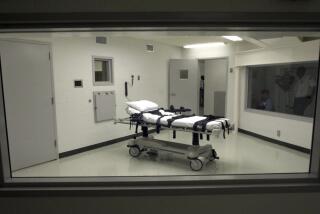Residents say there’s more to life than death row
It’s not that difficult to find the heart of this small east Texas city with wide-open spaces and lanky pine trees that breach the pale blue sky.
Cruise past the 67-foot statue of Sam Houston (who’s buried here), the town square and the plantation-style homes with the porches that wrap all the way around.
Turn on to Avenue I, and there it stands: high, red brick walls the color of a schoolhouse. Inside are cramped cinderblock cells, inmates, guards and — what put Huntsville on the map — death row. More than 400 inmates have been executed here since 1974.
Every execution in Texas since 1924 has been carried out in the Huntsville Unit, which has been aptly dubbed “the Walls.” The Rev. Jesse Jackson has marched here; Katie Couric has reported live from here. Residents say they can tell when there’s a controversial execution — they notice the strangers in town.
“Inside Huntsville, people don’t even know when there’s an execution,” unless it’s high profile, said Bill Williamson, a state police officer whose father worked at the Walls. “They know it’s a part of life, and that’s what happens.”
But Huntsville’s residents have a precarious relationship with its prisons. In addition to the Walls, there are four more prisons within Huntsville’s city limits and five more nearby.
The prison system is one of the biggest employers in Huntsville (note to the unemployed: they’re hiring), and practically everyone in town falls within a couple degrees of separation from someone who makes a living at a prison.
Still, many bristle at how death row has shaped the identity of Huntsville to outsiders. They point to Sam Houston State University, which has about 17,000 students, and the school’s namesake, who was governor when Texas became a state and president when it was a republic.
“We don’t talk about the prison,” said Kathryn Nickell, a retired schoolteacher who first came to Huntsville in 1965 to attend Sam, as the locals call the university. “They talk about Huntsville being the death capital. But we’ve got more than that.”
Jim Willett, the retired warden of the Walls, said there’s no denying how much Huntsville has relied on the jobs the prisons have provided. About half of Huntsville’s 35,000 residents are state employees.
“You take away the prison system and the college,” Willett said, “we probably wouldn’t have a red light in this town.”
Willett is now director of the Texas Prison Museum in Huntsville, which tells the history of Texas’ prison system and its development into a behemoth with nearly 150,000 inmates. The museum, complete with a watchtower and a mannequin standing guard, contains a scale model of the Walls and the area of town that surrounds it.
Like many in Huntsville, Willett can highlight points of his life by referring to the map. He shined his green laser pointer on the watchtower where he started, working the 10 p.m.-to-6 a.m. shift as a guard while he majored in business at Sam.
Willett never intended on staying at the prison. But that’s how things worked out.
He shifted the laser to the other side of the Walls compound, to death row, where, as warden, he oversaw 89 executions. He said he doesn’t take issue with the death penalty; he was just troubled by the notion of able-bodied men, often younger than him, dying.
A large portion of the museum, which offers a yellow line on its cement floors to guide visitors, is dedicated to the death penalty. Old Sparky, the state’s old electric chair, is on display, as are three syringes showing the newer method of execution — a three-chemical cocktail that sedates, paralyzes and then induces cardiac arrest.
Next to that is the last meal request of “Morrow, Jr., J.H. # 321,” who scrawled his order of a small steak with French fries, hot biscuits and a banana split in cursive on a sheet of notebook paper: “This is my last meal, and damn it, I want it served hot on however many plates and bowls it takes to keep it from mixing any of it up together.”
There’s also a display on contraband, such as the boot with a hidden compartment that belonged to the father of actor Woody Harrelson. Charles Harrelson was locked up for killing a federal judge in San Antonio.
At the entrance to the exhibits is an elaborate wooden sculpture. An inmate in the woodworking unit crafted intricate figures of animals into an uprooted tree stump that prison guards gave him to work with.
The prisoner finished his sentence before his project but, as fate would have it, the ex-inmate was caught violating his parole. He ended up back in the Walls, where he had plenty of time on his hands. Such is life for at least some residents of Huntsville, Texas.
More to Read
Sign up for Essential California
The most important California stories and recommendations in your inbox every morning.
You may occasionally receive promotional content from the Los Angeles Times.










